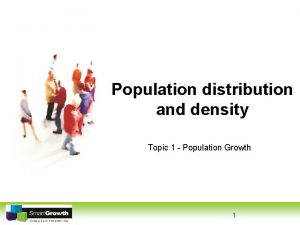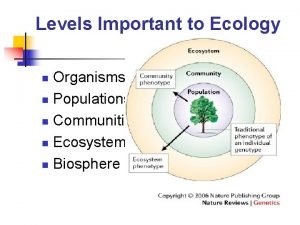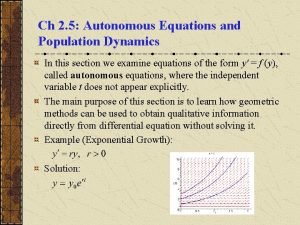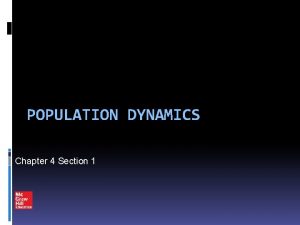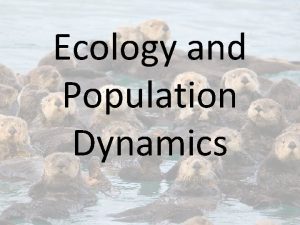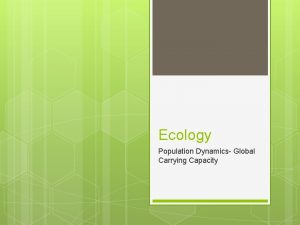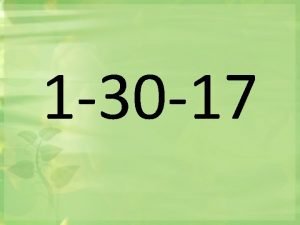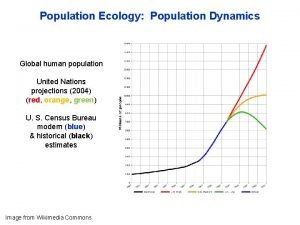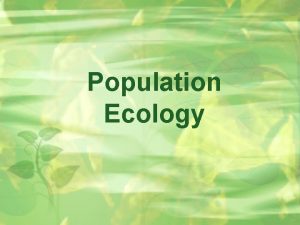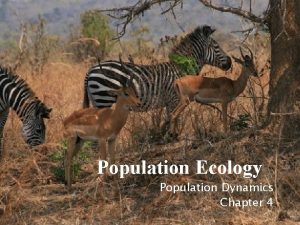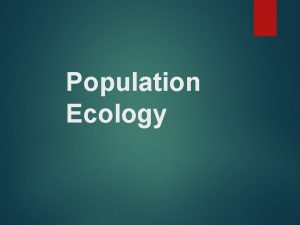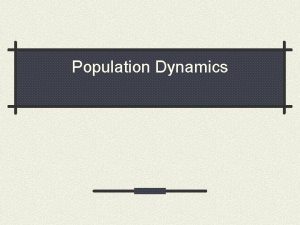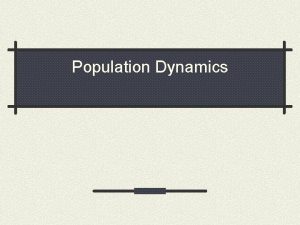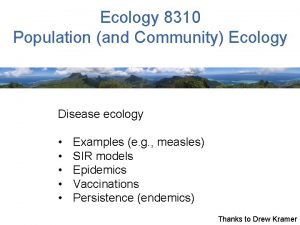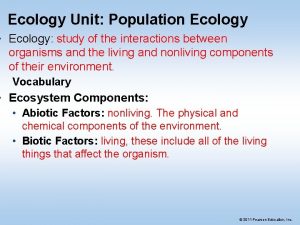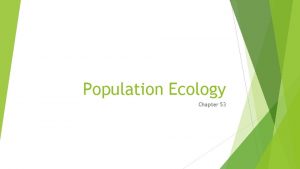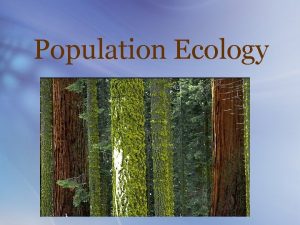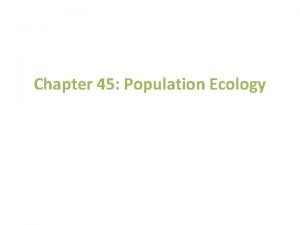Ch 4 Population Ecology 4 1 Population Dynamics























- Slides: 23

Ch 4: Population Ecology 4. 1 - Population Dynamics

CH 4. 1 – Essential Questions l What are the characteristics of populations and how are they distributed? l What are the differences between densityindependent and density-dependent limiting factors? l What are the similarities between the different models used to quantify the growth of a population? l How does carrying capacity affect reproductive rates?

Population Density l All species occur in groups called populations. l Population Density – the number of individuals per unit land area (or water volume).

Dispersion – the pattern of spacing of a population within an area. It can be: l Clumped – found in groups l Uniform – evenly spread out l Random – more spread out, but not even

Population Range l No population occupies all habitats in the biosphere. l A species range of tolerance may not be able to handle the abiotic or biotic factors in a habitat. l Biotic and abiotic factors may change leaving the population to find a new habitat.

Limiting Factors What limits growth? Abiotic and biotics factors such as… l. Food l. Disease l. Predators l. Lack of space

Limiting Factors l Limiting factors can be biotic or abiotic. l They keep a population from growing. l There are two types: 1. Density Dependent – usually biotic and include predation, disease, parasites, and competition 2. Density Independent – usually abiotic (nonliving) and include drought, floods, extreme heat or cold, tornadoes, and hurricanes.

Population Demographics l Demography is the study of population characteristics such as growth rate, age structure and movement of individuals. l Birth Rate is the number of live births per 1000 people in a given year. l Death Rate is the number of deaths per 1000 people in a given year. l To see if a population is growing or declining, subtract the death rate from the birth rate

Population Demographics l Immigration (In) – People (or animals) moving in… l Emigration (Exit) – People (or animals) moving out… l PGR - Population Growth Rate = I – E to see if a population is growing or declining…

Population Growth Rate l Exponential Growth – rapid growth, usually unrestricted (sometimes a sharper J- curve). l Growth Curve – is shown as a “J” shape on a graph l Has a lag phase and a growth phase.

Logistic Growth Model l Carrying Capacity – the largest population of a species that a certain environment can support. l These pressures will cause an “S” shaped (stabilized) growth curve. The “J” stabilizes into the “S”.

Carrying Capacity l Carrying capacity can change due to food supply, weather, etc. Example: If farmers use fertilizer, they can produce crops and feed more people than before.

Ch 4: Population Ecology 4. 2 – Human Population

CH 4. 2 – Essential Questions l What aspects affect human growth? l What are the trends in human population growth? l What are the age structures of representative non-growing, slowlygrowing, and rapidly growing countries? l What might be the consequences of continued population growth?

Human Population

Demography l Demography is the study of human population size, density, distribution, movement, and birth and death rates. l Technology, better healthcare, better nutrition have all led to an explosion in human growth.

Surviorship Curves – Individuals l Type I: a convex curve. Most individuals live to adulthood with most mortality occurring during old age. Ex: hippos, humans, deer, elephants. l Type II: a straight line. An individual’s chance of dying is independent of its age. Ex: small birds, reptiles and mammals. l Type III: a concave curve, few individuals live to adulthood, with the chance of dying decreasing with age. Ex: insects, oysters, redwood trees, snapping turtles.


4 Stages of Demographic Transition l Stage 1: High fluctuation - high birth rate and death rates - however population growth is small. l Stage 2: High birth rate but falling death rate. The total population begins to expand rapidly. l Stage 3: Falling birth rate, continuing falling death rate. The population growth slows down. l Stage 4: low fluctuating, low birth rate and low death rate. The population growth is small, and fertility continues to fall.


Growth and Age Structure l Zero Population Growth – When (births + immigration) = (deaths + emigration) l Age Structure Graphs – a special graph that breaks up a population by age and gender to see if the population is growing rapidly, slowly, or declining. l These rates differ among countries.

The 3 Shapes of Growth

Human Carrying Capacity l Humans have a carrying capacity too. l We don’t know what it will be. l We need to conserve resources!
 Population ecology section 1 population dynamics
Population ecology section 1 population dynamics Population ecology chapter 4 answers
Population ecology chapter 4 answers Chapter 4 section 1 population dynamics study guide
Chapter 4 section 1 population dynamics study guide Section 1 population dynamics answer key
Section 1 population dynamics answer key Chapter 53 population ecology
Chapter 53 population ecology Chapter 53 population ecology
Chapter 53 population ecology Chapter 53 population ecology
Chapter 53 population ecology Is india near the equator
Is india near the equator Population definition ecology
Population definition ecology Chapter 36 population ecology
Chapter 36 population ecology Chapter 4 section 1 population dynamics
Chapter 4 section 1 population dynamics Population characteristics ecology
Population characteristics ecology Ecosystem vs community
Ecosystem vs community Population ecology
Population ecology Chapter 4 population ecology answer key
Chapter 4 population ecology answer key Clumped dispersion
Clumped dispersion Population characteristics
Population characteristics Concept 3 population ecology
Concept 3 population ecology Parasitism pictures
Parasitism pictures Lynx and hare relationship
Lynx and hare relationship Exponential growth equation ecology
Exponential growth equation ecology What is population ecology
What is population ecology Autonomous equations and population dynamics
Autonomous equations and population dynamics Study guide chapter 4 section 1 population dynamics
Study guide chapter 4 section 1 population dynamics













